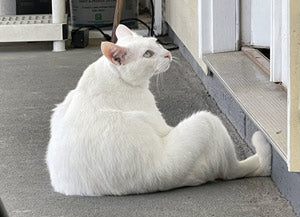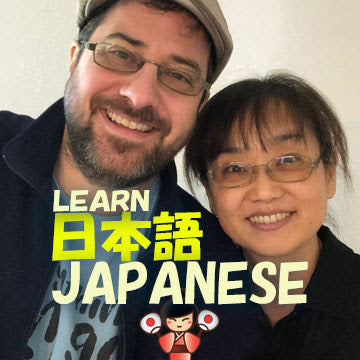Welcome to this week's Sunday Haiku.
Each Sunday, spend a few minutes enjoying a haiku or some facet of Japanese culture. Makoto+ Shogun (or Lifetime) members, click here for almost 100 haiku lessons with sound. (Not yet a member, let's fix that!)
But first, let's catch up on our new posts from the last week (all FREE except the last one):
- J-Pop Song: Wednesday Campanella Edison エジソン Lyrics in Japanese and English [UPPER BEGINNER+]
- See all our J-Pop vocabulary lessons here (totally free, but Makoto+ members (both Samurai and Shogun) have bonus download content)
- Beginning Japanese Phrases Podcast Phrases 77: ~ないで naide – don’t (do) [BEGINNERS]
- Nihongo no Tane 79 人前でのスピーチ Speaking in Front of Others | Japanese Immersion Podcast [LOWER INTERMEDIATES+]
- And just as a reminder, for a limited time, get all 50 Makoto issues for only $2 each (or $1 each if you are a Makoto+ member--check your members area for the coupon).

It's 花見【はなみ】 time in Japan (at least in parts of Japan).
To celebrate, let's...
- Learn a few important sakura-related vocabulary words
- Examine a seemingly simple haiku by Shiki
A print by Utagawa Hiroshige, part of his 36 views of Mount Fuji series

MPORTANT VOCABULARY:
花見【はなみ】
Let's start with the above 花見 hanami. It means "flower viewing" or literally "flower see" and refers to the gathering of friends and coworkers under a blooming tree to drink, chat, and enjoy the scenery.
花見 is a very old custom, going back perhaps as far as the Nara period (710-794).
桜【さくら】
Sakura. Cherry blossoms. Want to learn the traditional Japanese song? Click here to hear Yumi sing it.
Our cat's name is Sakura. Here's a photo I took last week of her contemplating the もののあわれ (the fleeting pathos of things) of this year's cherry blossoms.

Look at the kanji: 桜 It's an image of a woman 女 sitting under a tree 木 while the blossoms fall upon her. Oftentimes, kanji is beautiful (and easy to remember) like that.
花吹雪【はなふぶき】
Falling cherry blossoms. Literally, "花 (flower) + 吹雪 (blizzard; snow storm)"
When I was younger and less mature, I would turn to Yumi and say, 「失礼【しつれい】。ちょっと花吹雪します!」 and then proceed to blow my nose.
はな, you see, can mean 花 (flower) or 鼻 (nose).
Yumi told me that kind of ruined the beauty of the word 花吹雪 for her.
It's a wonder she has stuck with me for all these years (we married in 1999!).
I should also apologize for ruining your Sunday. 申【もう】し訳【わけ】ございません。
ソメイヨシノ
The most common species of cherry trees is called ソメイヨシノ. As many as 80% of all cherry blossom trees in Japan are this variety. It is said nearly all of these trees are clones from one or two original trees dating from the Edo period.
If you are a Makoto+ member, you can read about this here. If you want more, pick up our Sightseeing in Japan bundle here.
HAIKU
This Masaoka Shiki 【正岡子規】 (1867-1902) haiku is found in the latest Makoto issue (#50). If you are a Makoto+ member, please see the issue here.
今年また 花散る 四月十二日
kotoshi mata / hana chiru / shigatsu juu ni nichi
This year again | blossoms fall | on April 12
Vocabulary:
- 今年 this year [今 (now; currently; present) + 年 (year)]
- また also; too; as well; again
- 花 flower; blossom; bloom; petal
- 散る to fall (e.g. blossoms, leaves)
- 四月十二日 April 12; 12th day of April; 12th of April [四月 (April; 四 (four) + 月 (month)) + 十二日 (12th day of the month; 十二 (twelve) + 日 (day (of the month); counter for days))]
This poem is seemingly straightforward. He mentions the blossoms are falling again this year and notes the date. Shiki was known for his realistic observation of nature.
And yet, two points deepen this haiku.
First, the cherry blossoms are a fleeting beauty, lasting only a week or so.
Second, by the time he wrote this haiku, Shiki had began coughing up blood. He suffered from tuberculosis and would only live to be 34.
The cherry blossoms only fell 34 times during Shiki's short life. This haiku marks one of these occasions. Shouldn't we also stop to consider the beauty in this fleeting life?
Like this haiku lesson? Did you know we have almost a hundred other haiku lessons on Makoto+ now? All have vocabulary and grammar breakdowns with sound and cultural notes. Shogun and lifetime members have unlimited access to all lessons.
I intend to write more free lesson newsletters like this in the future, but please consider becoming a member today. Your support is greatly appreciated. Yumi and I promise we will do our best to support you on your Japanese language journey.

Thank you,
Clay & Yumi
P.S. Want to learn more about what Makoto is all about? We just made a video flipping through all the pages of the latest issue (#50). Check it out:




